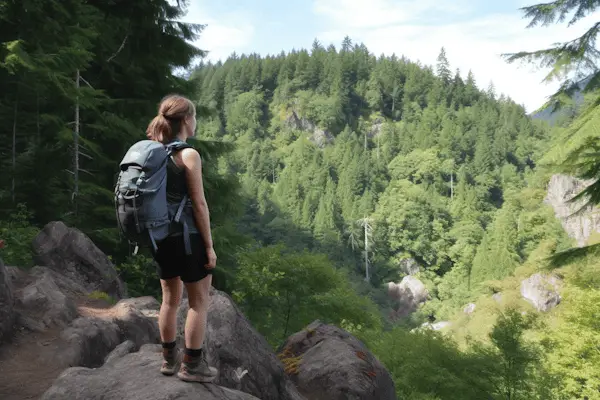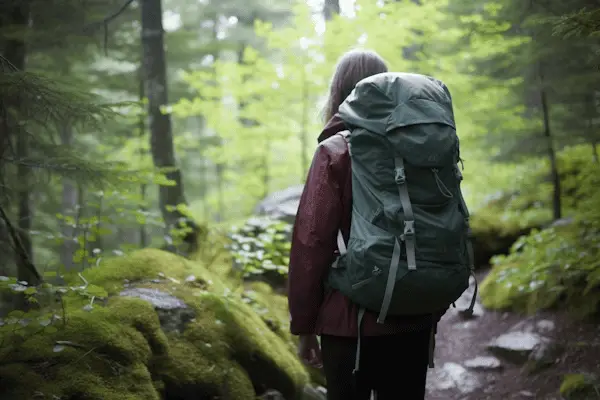Switchback hiking has become popular among hikers, athletes, and fitness enthusiasts but what is a switchback in hiking?
A switchback in hiking refers to a trail that zigzags its way up or down a steep slope. The purpose of a switchback is to make the trail less strenuous and safer by reducing the steepness of the incline.
Have you been on a switchback before? Probably. So, you know when you’re hiking up or down a super steep slope, and instead of going straight up or down, the trail kind of zigzags back and forth? That’s a switchback. It’s a clever trick that makes the hike a bit easier and safer because it’s not as steep.
You’ll often spot these switchbacks in the mountains. Rather than having you climb straight up the face, the path crisscrosses up the mountain, making the journey a bit longer but definitely less steep.
Advantages of Switchback Trail Hiking
There are plenty of awesome benefits when it comes to switchback trails. You see, these trails aren’t just designed to give your hiking boots a workout – they’re all about helping you, the trail, and even the mountain!
Switchback Trails Make Hikes Easier
First things first, the most obvious benefit is they make the climb a whole lot easier. Think about it. Would you rather be huffing and puffing, trying to scramble straight up a steep incline, or would you prefer a more leisurely, winding ascent? That’s what a switchback does – it kind of takes the edge off a tough climb.
And let’s not forget about the safety aspect of switchbacks. You see, steep slopes can be pretty treacherous, especially if the weather’s not so great. One slip, and you could find yourself in a bit of a pickle. But with switchbacks, the trail’s a lot safer. The gentler gradient reduces the risk of slipping or losing your footing.
Plus, switchbacks often give you more stable terrain to work with, so you can focus more on the beautiful surroundings rather than worrying about keeping your balance. So, not only does a switchback make your hike less strenuous, but it also makes it safer.
Switchback Trails Help Prevent Erosion
Then, there’s the trail itself. It might not seem like it, but switchbacks are a great way to prevent erosion. If everyone was just stomping straight up the hill, it would cause a lot of damage to the trail over time. But by zigzagging our way up, we help to keep the path in better shape for the next adventure seekers.
And guess what? Switchbacks are also a gift to the environment. By using these trails, we’re reducing our impact on the mountain’s ecosystems. We’re helping to protect the vegetation and the wildlife that calls the mountain home.
Switchbacks Offer Amazing Views
Let’s not forget the views! Switchback trails often lead to some seriously breathtaking views. Every turn might offer a new perspective of the landscape. It’s like a little surprise waiting at each bend.
So yeah, switchbacks are pretty cool. They make the hike easier, protect the trails and the environment, and serve up some great photo ops!

Switchback Trail Hiking vs Direct Trails
When you’re looking at switchback trails versus direct trails, it’s a bit like comparing a scenic winding country road with a highway. Both will get you to where you’re going, but the experience is going to be pretty different.
Let’s start with direct trails. Direct trails are like the ‘no-nonsense’ route. They take the shortest, straightest line up or down the hill. They’re usually steeper, and they can be pretty tough going, especially if you’re new to hiking or if you’re not in peak shape. And when it’s wet? Yikes, those direct trails can get super slippery, super fast. But hey, if you’re after a quick, intense workout, then a direct trail might be just what you’re looking for.

On the other hand, switchback trails are all about taking it easy. They zigzag their way up or down, which makes the slope gentler and the hike more manageable. It’s kind of like taking baby steps: you’re still climbing the same mountain, but you’re doing it in smaller, easier chunks. Sure, it might take you a bit longer to get to the top, but you’ll probably enjoy the journey a lot more. And did I mention the views? With all those twists and turns, you get to see the landscape from all kinds of different angles. Plus, they’re usually less slippery and safer, especially in wet conditions.
Bottom line? If you’re all about the challenge and getting a serious workout, you might prefer a direct trail. But if you’re more into a relaxing, scenic hike and preserving the environment, then a switchback trail is probably more your speed.
8 Switchback Hiking Tips
So, you’re thinking about hitting a switchback trail, huh? Awesome choice! There’s something pretty special about winding your way up a mountainside, with each twist and turn offering a new stunning view. But before you lace up those hiking boots, there are a few things you should know to make your adventure the best it can be.
Here are eight tips for hiking switchback trails.
1. Slow and Steady: The Art of Pacing on a Switchback Trail
Remember that hiking is not a sprint; it’s more of a marathon. Especially with switchbacks, where you’re dealing with a winding path, it’s important to keep a steady, easy-going pace. Trust me, there’s nothing worse than burning out halfway through your hike because you bolted out of the gate too quickly.
Also, don’t forget to take some breaks. Seriously, it’s okay to stop and catch your breath. Actually, it’s more than okay—it’s a chance to truly take in the amazing views around you. So don’t feel like you have to power through without stopping. Take your time and enjoy the journey.
2. Respect The Path: Never Cut Switchback Trails
It might be tempting to take a shortcut on those bends but resist that urge. It’s really not cool to cut across switchbacks. Why? Well, it can lead to soil erosion and damage the trail, making it tough for future hikers.
Plus, it’s not just about the trail; it’s about the whole ecosystem. Going off the designated path can disturb the local wildlife and plants. So let’s do our bit for Mother Nature, and stick to the path, okay?
3. Mind Your Step: Navigating the Turns Safely
Switchbacks can get a little tricky underfoot. Because of the constant turns, you can sometimes find loose soil or rocks. So make sure you’re keeping an eye on where you’re stepping.
Don’t just look at the beautiful vistas, watch your feet as well. We don’t want any twisted ankles or tumbles. Safety first, right?
4. Fueling Up: The Importance of Hydration and Snacks on the Trail
Just like any workout, you gotta stay hydrated and fueled. On a long switchback trail, it’s important to take regular water breaks. Always have a water bottle handy, and don’t wait till you’re thirsty to take a sip.
And let’s not forget about snacks. Energy bars, nuts, fruit—whatever keeps you going. Remember, you’re likely burning more calories than you think, so keep your energy levels up with some healthy snacks. Are Cliff Bars beating up your budget? Take a look at this list of 21 cheap backpacking foods to eat while on the trail.
5. Leaving Only Footprints: Embracing the ‘Leave No Trace’ Philosophy
Whatever we carry in, we gotta carry out. That means no leaving trash behind. It’s all about preserving these beautiful trails for future generations. So, if you’re having a snack or a drink, make sure you’re packing your wrappers and bottles back in your bag.
And it’s not just about trash—it’s about not disturbing the trail in any way. That means no picking flowers or moving rocks. Let’s leave the trail as natural and undisturbed as we found it.
6. The Scenic Route: Taking Time to Appreciate the View
One of the best things about switchbacks? The stunning views. Because the trail zigzags up the mountain, you get different perspectives at every turn. So, don’t be so focused on the climb that you forget to stop and take it all in.
Seriously, take a moment to appreciate the beauty around you. Maybe even snap a few pics. These are the moments you’ll want to remember once the hike is over.
7. Respect Others: Right of Way Rules On Switchback Trails
Remember, you’re not the only one on the trail. If you’re coming downhill and meet hikers going uphill, it’s common courtesy to step aside and let them pass. It’s tougher to hike uphill, so we give those folks the right of way.
And let’s be conscious of our noise level, too. Many people go hiking to enjoy the peace and quiet of nature, so let’s respect that and keep our voices down. It makes the experience better for everyone.
8. Dressing for Success: Choosing the Right Outfit for Switchback Hiking
Lastly, don’t forget about your outfit. The weather in the mountains can change pretty quickly, so it’s a good idea to dress in layers. That way, you can add or remove layers as needed. And, of course, sturdy hiking boots are a must. You need good grip and ankle support, especially on a switchback trail.
Also, don’t forget to check the weather before you head out. You don’t want to be caught in a rainstorm unprepared. Being comfortable and safe makes the hike a lot more enjoyable.
